Report on System Analysis and Design: Methodologies and Diagrams
VerifiedAdded on 2020/03/16
|15
|1945
|31
Report
AI Summary
This report provides a detailed analysis of system analysis and design, focusing on three key software development methodologies: Scrum, XP (Extreme Programming), and the Unified Process (UP). The report begins with an overview of each methodology, discussing their descriptions, advantages, and disadvantages. It then delves into the practical application of these concepts, including an event table outlining various system events and their responses, a use case describing the process of creating a customer, and a use case description. The report also includes a class diagram and a domain model class diagram to visually represent the system's structure and relationships. Finally, the report includes a bibliography of relevant sources and an appendix with a memo. This comprehensive analysis provides a valuable resource for understanding and applying system analysis and design principles.

Running head: THE SYSTEM ANALYSIS AND DESIGN
The System Analysis and Design
Name of the Student
Name of the University
The System Analysis and Design
Name of the Student
Name of the University
Paraphrase This Document
Need a fresh take? Get an instant paraphrase of this document with our AI Paraphraser
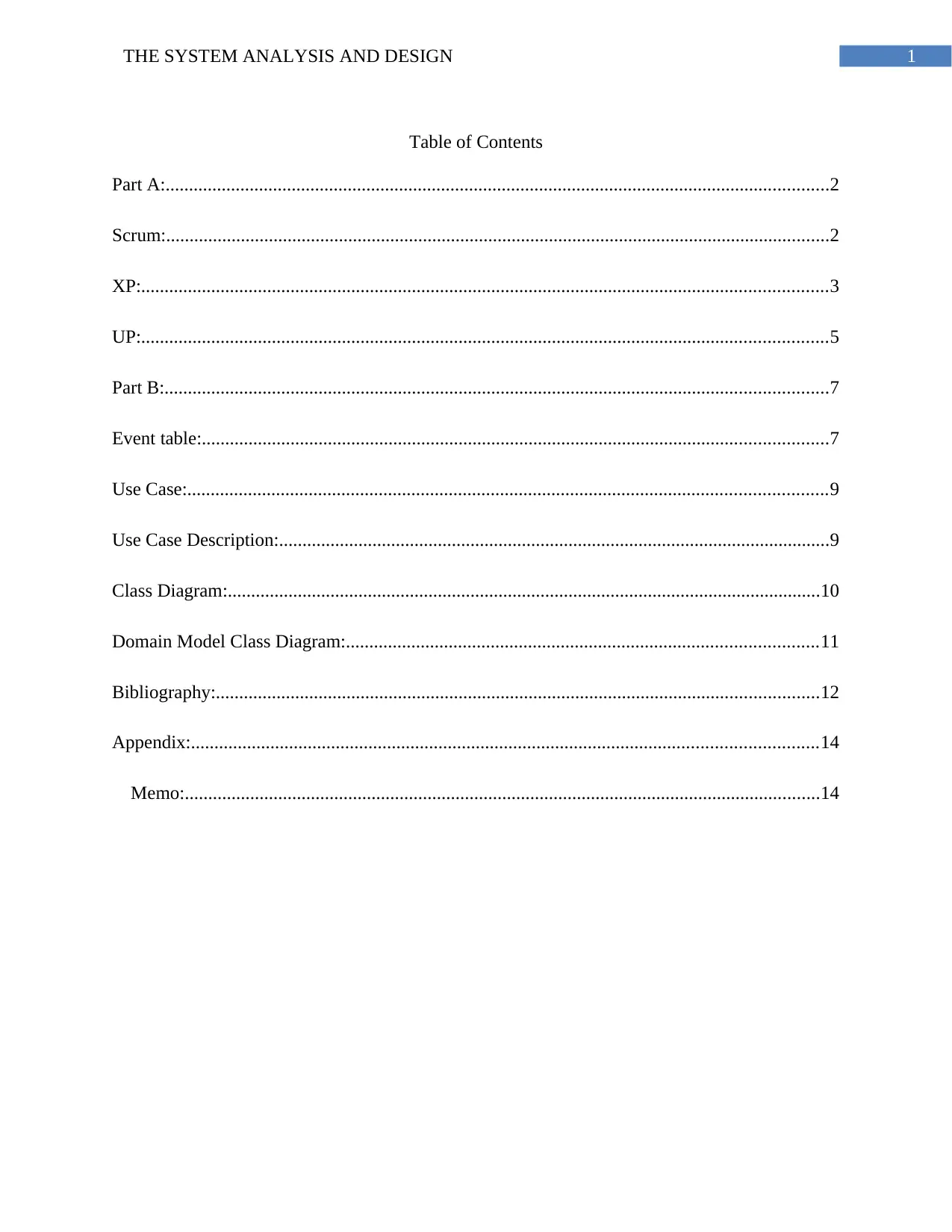
1THE SYSTEM ANALYSIS AND DESIGN
Table of Contents
Part A:..............................................................................................................................................2
Scrum:..............................................................................................................................................2
XP:...................................................................................................................................................3
UP:...................................................................................................................................................5
Part B:..............................................................................................................................................7
Event table:......................................................................................................................................7
Use Case:.........................................................................................................................................9
Use Case Description:......................................................................................................................9
Class Diagram:...............................................................................................................................10
Domain Model Class Diagram:.....................................................................................................11
Bibliography:.................................................................................................................................12
Appendix:......................................................................................................................................14
Memo:........................................................................................................................................14
Table of Contents
Part A:..............................................................................................................................................2
Scrum:..............................................................................................................................................2
XP:...................................................................................................................................................3
UP:...................................................................................................................................................5
Part B:..............................................................................................................................................7
Event table:......................................................................................................................................7
Use Case:.........................................................................................................................................9
Use Case Description:......................................................................................................................9
Class Diagram:...............................................................................................................................10
Domain Model Class Diagram:.....................................................................................................11
Bibliography:.................................................................................................................................12
Appendix:......................................................................................................................................14
Memo:........................................................................................................................................14

2THE SYSTEM ANALYSIS AND DESIGN
Part A:
Scrum:
Description: Scrum depends on using a cross-functional team. The team members of
scrum is self-organizing regarding the cause, which there is not another complete team leader
who is able to decide the works of team members related to the project or takes initiation in the
problem solving among employees and project in-scope issues (Turk, France and Rumpe 2014).
These reasons can be considered as the conditions, which are absolute through the team
members, collectively, to be complete. Inside the agile Scrum approach, rather than providing
complete, detailed descriptions of how all things are usually to become done on a task, the most
of it is left roughly the Scrum application implementation team. The reason why being the team
will know best how to fix the trouble they can be presented (Abrahamsson et al. 2017).
Advantages: The advantages are as following.
1) Scrum makes sure that proper usage of capital and time is done
2) The coding and testing is done during the sprint review phase
3) The project can be divided into small parts so that it can be achieved easily
4) It allows the project manager to get feedback from the end users and customer
5) If the project is fast moving then Scrum is perfect for the project (Fuggetta and Di
Nitto 2014)
6) The daily scrum meetings are a great way of understanding the individual effort
of each team members
7) The short sprints are beneficial regarding entering new changes in the project
Part A:
Scrum:
Description: Scrum depends on using a cross-functional team. The team members of
scrum is self-organizing regarding the cause, which there is not another complete team leader
who is able to decide the works of team members related to the project or takes initiation in the
problem solving among employees and project in-scope issues (Turk, France and Rumpe 2014).
These reasons can be considered as the conditions, which are absolute through the team
members, collectively, to be complete. Inside the agile Scrum approach, rather than providing
complete, detailed descriptions of how all things are usually to become done on a task, the most
of it is left roughly the Scrum application implementation team. The reason why being the team
will know best how to fix the trouble they can be presented (Abrahamsson et al. 2017).
Advantages: The advantages are as following.
1) Scrum makes sure that proper usage of capital and time is done
2) The coding and testing is done during the sprint review phase
3) The project can be divided into small parts so that it can be achieved easily
4) It allows the project manager to get feedback from the end users and customer
5) If the project is fast moving then Scrum is perfect for the project (Fuggetta and Di
Nitto 2014)
6) The daily scrum meetings are a great way of understanding the individual effort
of each team members
7) The short sprints are beneficial regarding entering new changes in the project
⊘ This is a preview!⊘
Do you want full access?
Subscribe today to unlock all pages.

Trusted by 1+ million students worldwide
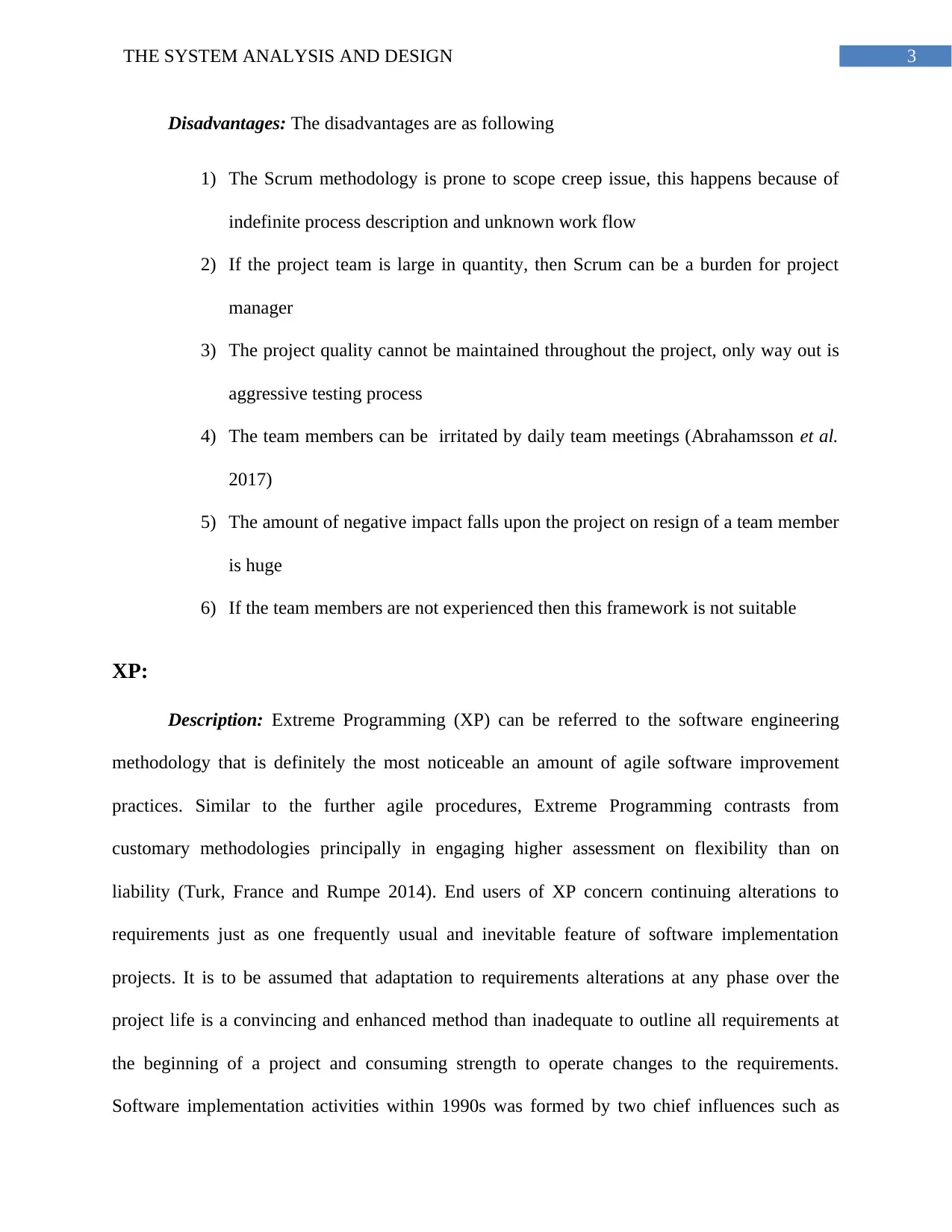
3THE SYSTEM ANALYSIS AND DESIGN
Disadvantages: The disadvantages are as following
1) The Scrum methodology is prone to scope creep issue, this happens because of
indefinite process description and unknown work flow
2) If the project team is large in quantity, then Scrum can be a burden for project
manager
3) The project quality cannot be maintained throughout the project, only way out is
aggressive testing process
4) The team members can be irritated by daily team meetings (Abrahamsson et al.
2017)
5) The amount of negative impact falls upon the project on resign of a team member
is huge
6) If the team members are not experienced then this framework is not suitable
XP:
Description: Extreme Programming (XP) can be referred to the software engineering
methodology that is definitely the most noticeable an amount of agile software improvement
practices. Similar to the further agile procedures, Extreme Programming contrasts from
customary methodologies principally in engaging higher assessment on flexibility than on
liability (Turk, France and Rumpe 2014). End users of XP concern continuing alterations to
requirements just as one frequently usual and inevitable feature of software implementation
projects. It is to be assumed that adaptation to requirements alterations at any phase over the
project life is a convincing and enhanced method than inadequate to outline all requirements at
the beginning of a project and consuming strength to operate changes to the requirements.
Software implementation activities within 1990s was formed by two chief influences such as
Disadvantages: The disadvantages are as following
1) The Scrum methodology is prone to scope creep issue, this happens because of
indefinite process description and unknown work flow
2) If the project team is large in quantity, then Scrum can be a burden for project
manager
3) The project quality cannot be maintained throughout the project, only way out is
aggressive testing process
4) The team members can be irritated by daily team meetings (Abrahamsson et al.
2017)
5) The amount of negative impact falls upon the project on resign of a team member
is huge
6) If the team members are not experienced then this framework is not suitable
XP:
Description: Extreme Programming (XP) can be referred to the software engineering
methodology that is definitely the most noticeable an amount of agile software improvement
practices. Similar to the further agile procedures, Extreme Programming contrasts from
customary methodologies principally in engaging higher assessment on flexibility than on
liability (Turk, France and Rumpe 2014). End users of XP concern continuing alterations to
requirements just as one frequently usual and inevitable feature of software implementation
projects. It is to be assumed that adaptation to requirements alterations at any phase over the
project life is a convincing and enhanced method than inadequate to outline all requirements at
the beginning of a project and consuming strength to operate changes to the requirements.
Software implementation activities within 1990s was formed by two chief influences such as
Paraphrase This Document
Need a fresh take? Get an instant paraphrase of this document with our AI Paraphraser
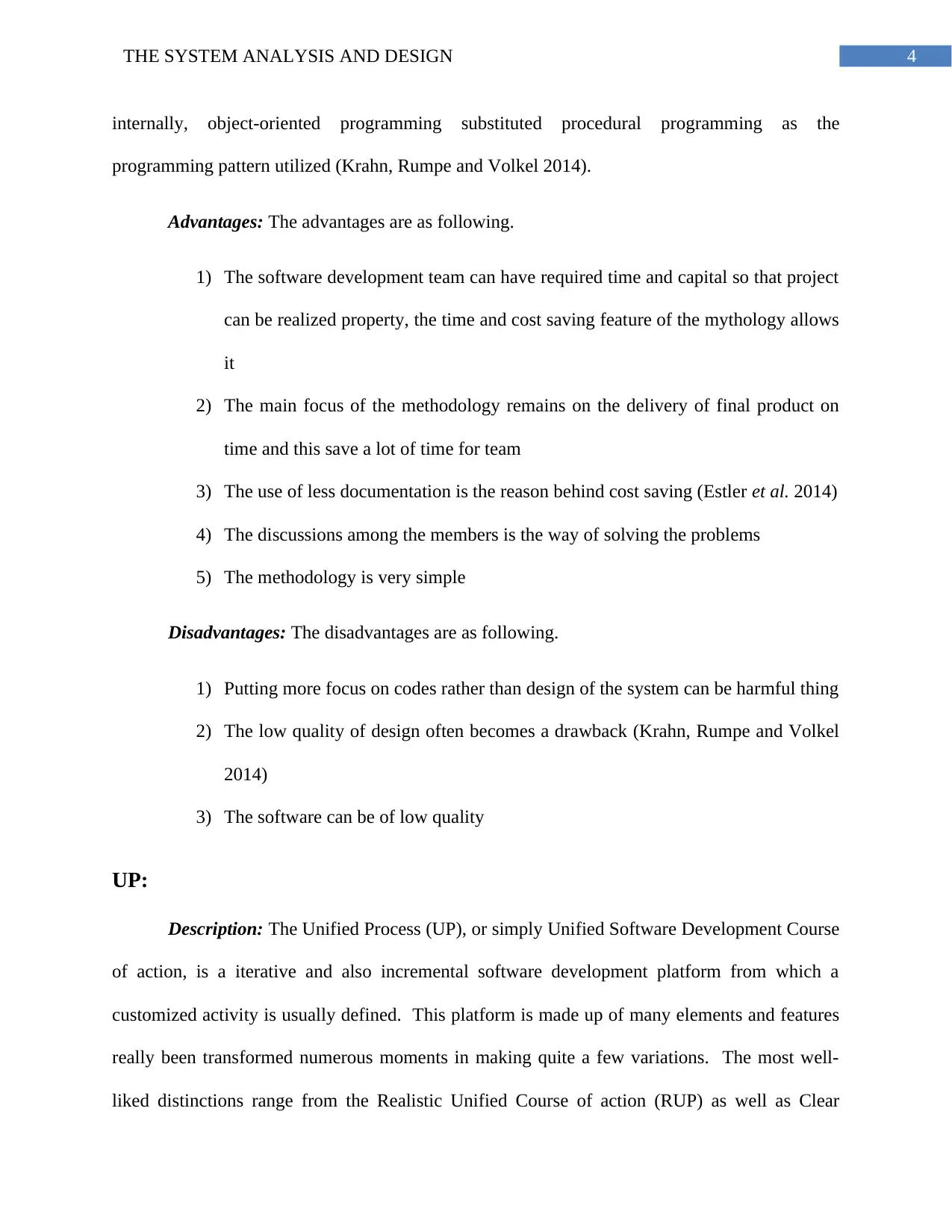
4THE SYSTEM ANALYSIS AND DESIGN
internally, object-oriented programming substituted procedural programming as the
programming pattern utilized (Krahn, Rumpe and Volkel 2014).
Advantages: The advantages are as following.
1) The software development team can have required time and capital so that project
can be realized property, the time and cost saving feature of the mythology allows
it
2) The main focus of the methodology remains on the delivery of final product on
time and this save a lot of time for team
3) The use of less documentation is the reason behind cost saving (Estler et al. 2014)
4) The discussions among the members is the way of solving the problems
5) The methodology is very simple
Disadvantages: The disadvantages are as following.
1) Putting more focus on codes rather than design of the system can be harmful thing
2) The low quality of design often becomes a drawback (Krahn, Rumpe and Volkel
2014)
3) The software can be of low quality
UP:
Description: The Unified Process (UP), or simply Unified Software Development Course
of action, is a iterative and also incremental software development platform from which a
customized activity is usually defined. This platform is made up of many elements and features
really been transformed numerous moments in making quite a few variations. The most well-
liked distinctions range from the Realistic Unified Course of action (RUP) as well as Clear
internally, object-oriented programming substituted procedural programming as the
programming pattern utilized (Krahn, Rumpe and Volkel 2014).
Advantages: The advantages are as following.
1) The software development team can have required time and capital so that project
can be realized property, the time and cost saving feature of the mythology allows
it
2) The main focus of the methodology remains on the delivery of final product on
time and this save a lot of time for team
3) The use of less documentation is the reason behind cost saving (Estler et al. 2014)
4) The discussions among the members is the way of solving the problems
5) The methodology is very simple
Disadvantages: The disadvantages are as following.
1) Putting more focus on codes rather than design of the system can be harmful thing
2) The low quality of design often becomes a drawback (Krahn, Rumpe and Volkel
2014)
3) The software can be of low quality
UP:
Description: The Unified Process (UP), or simply Unified Software Development Course
of action, is a iterative and also incremental software development platform from which a
customized activity is usually defined. This platform is made up of many elements and features
really been transformed numerous moments in making quite a few variations. The most well-
liked distinctions range from the Realistic Unified Course of action (RUP) as well as Clear
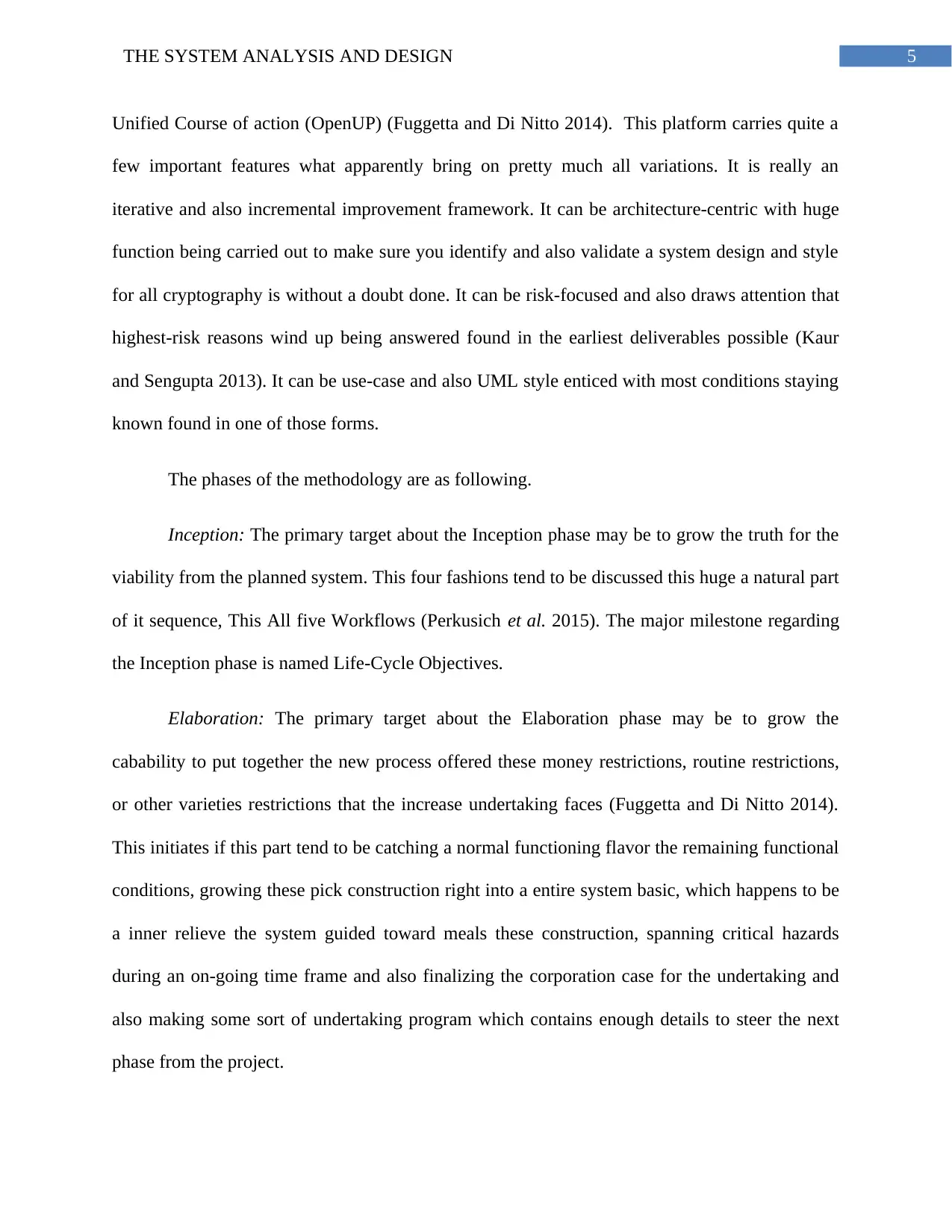
5THE SYSTEM ANALYSIS AND DESIGN
Unified Course of action (OpenUP) (Fuggetta and Di Nitto 2014). This platform carries quite a
few important features what apparently bring on pretty much all variations. It is really an
iterative and also incremental improvement framework. It can be architecture-centric with huge
function being carried out to make sure you identify and also validate a system design and style
for all cryptography is without a doubt done. It can be risk-focused and also draws attention that
highest-risk reasons wind up being answered found in the earliest deliverables possible (Kaur
and Sengupta 2013). It can be use-case and also UML style enticed with most conditions staying
known found in one of those forms.
The phases of the methodology are as following.
Inception: The primary target about the Inception phase may be to grow the truth for the
viability from the planned system. This four fashions tend to be discussed this huge a natural part
of it sequence, This All five Workflows (Perkusich et al. 2015). The major milestone regarding
the Inception phase is named Life-Cycle Objectives.
Elaboration: The primary target about the Elaboration phase may be to grow the
cabability to put together the new process offered these money restrictions, routine restrictions,
or other varieties restrictions that the increase undertaking faces (Fuggetta and Di Nitto 2014).
This initiates if this part tend to be catching a normal functioning flavor the remaining functional
conditions, growing these pick construction right into a entire system basic, which happens to be
a inner relieve the system guided toward meals these construction, spanning critical hazards
during an on-going time frame and also finalizing the corporation case for the undertaking and
also making some sort of undertaking program which contains enough details to steer the next
phase from the project.
Unified Course of action (OpenUP) (Fuggetta and Di Nitto 2014). This platform carries quite a
few important features what apparently bring on pretty much all variations. It is really an
iterative and also incremental improvement framework. It can be architecture-centric with huge
function being carried out to make sure you identify and also validate a system design and style
for all cryptography is without a doubt done. It can be risk-focused and also draws attention that
highest-risk reasons wind up being answered found in the earliest deliverables possible (Kaur
and Sengupta 2013). It can be use-case and also UML style enticed with most conditions staying
known found in one of those forms.
The phases of the methodology are as following.
Inception: The primary target about the Inception phase may be to grow the truth for the
viability from the planned system. This four fashions tend to be discussed this huge a natural part
of it sequence, This All five Workflows (Perkusich et al. 2015). The major milestone regarding
the Inception phase is named Life-Cycle Objectives.
Elaboration: The primary target about the Elaboration phase may be to grow the
cabability to put together the new process offered these money restrictions, routine restrictions,
or other varieties restrictions that the increase undertaking faces (Fuggetta and Di Nitto 2014).
This initiates if this part tend to be catching a normal functioning flavor the remaining functional
conditions, growing these pick construction right into a entire system basic, which happens to be
a inner relieve the system guided toward meals these construction, spanning critical hazards
during an on-going time frame and also finalizing the corporation case for the undertaking and
also making some sort of undertaking program which contains enough details to steer the next
phase from the project.
⊘ This is a preview!⊘
Do you want full access?
Subscribe today to unlock all pages.

Trusted by 1+ million students worldwide
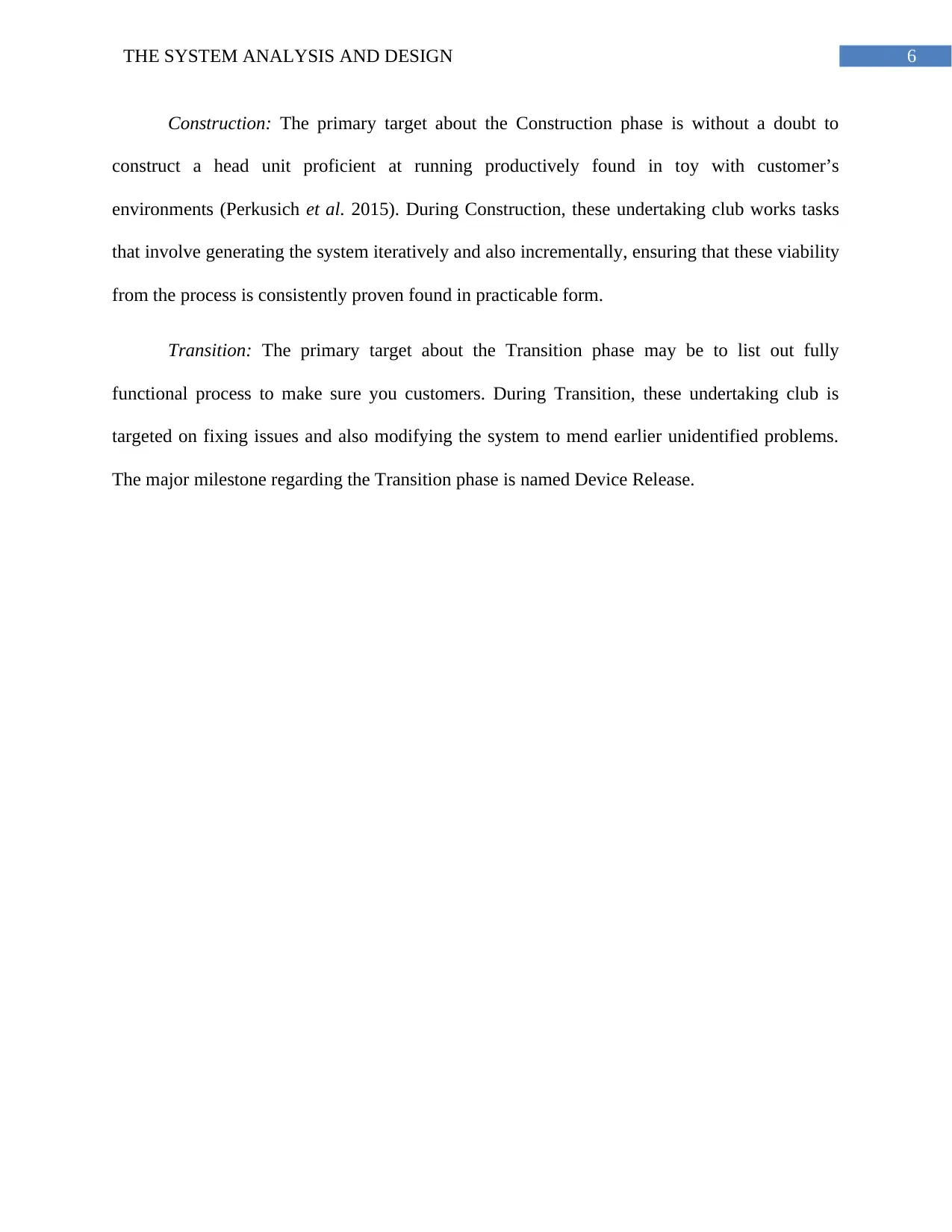
6THE SYSTEM ANALYSIS AND DESIGN
Construction: The primary target about the Construction phase is without a doubt to
construct a head unit proficient at running productively found in toy with customer’s
environments (Perkusich et al. 2015). During Construction, these undertaking club works tasks
that involve generating the system iteratively and also incrementally, ensuring that these viability
from the process is consistently proven found in practicable form.
Transition: The primary target about the Transition phase may be to list out fully
functional process to make sure you customers. During Transition, these undertaking club is
targeted on fixing issues and also modifying the system to mend earlier unidentified problems.
The major milestone regarding the Transition phase is named Device Release.
Construction: The primary target about the Construction phase is without a doubt to
construct a head unit proficient at running productively found in toy with customer’s
environments (Perkusich et al. 2015). During Construction, these undertaking club works tasks
that involve generating the system iteratively and also incrementally, ensuring that these viability
from the process is consistently proven found in practicable form.
Transition: The primary target about the Transition phase may be to list out fully
functional process to make sure you customers. During Transition, these undertaking club is
targeted on fixing issues and also modifying the system to mend earlier unidentified problems.
The major milestone regarding the Transition phase is named Device Release.
Paraphrase This Document
Need a fresh take? Get an instant paraphrase of this document with our AI Paraphraser
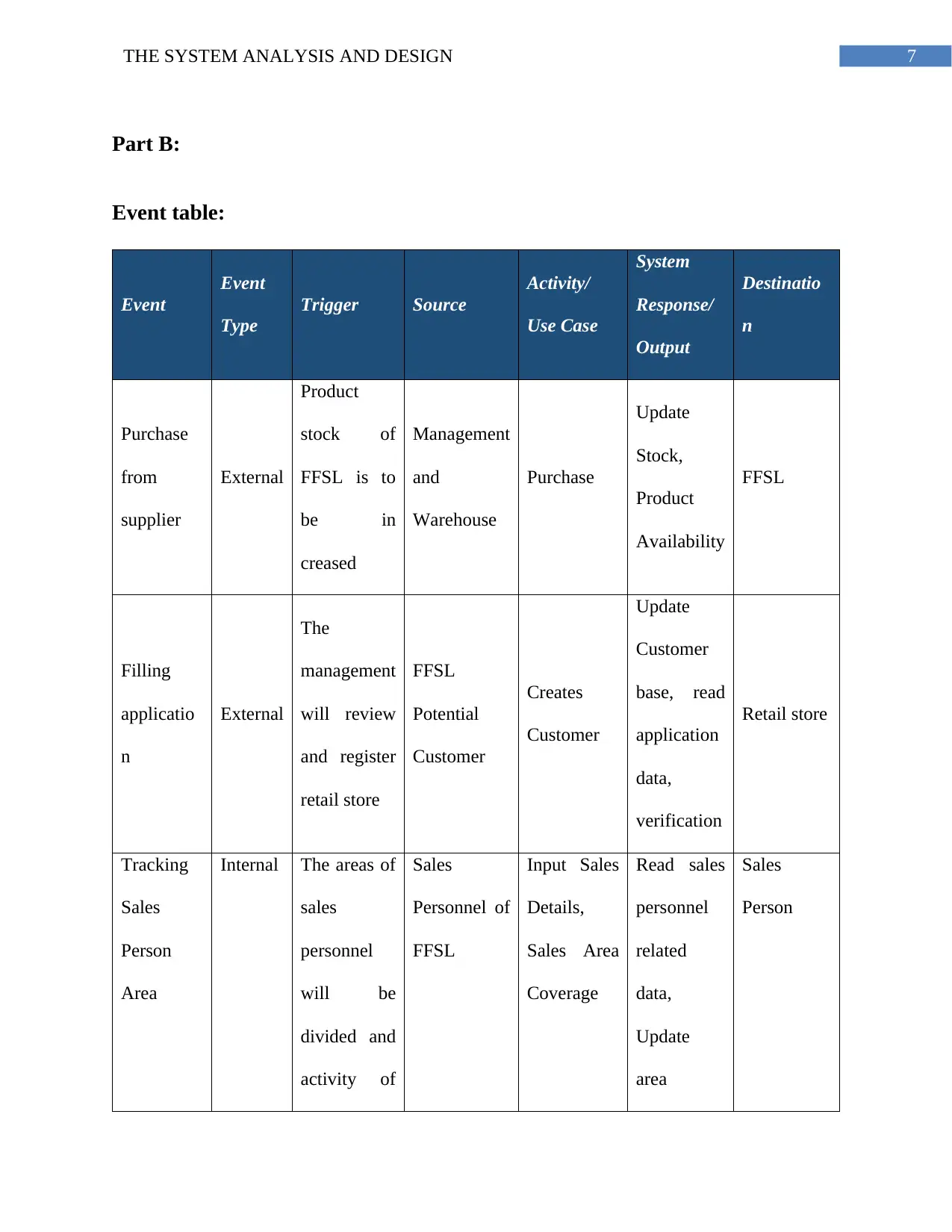
7THE SYSTEM ANALYSIS AND DESIGN
Part B:
Event table:
Event
Event
Type
Trigger Source
Activity/
Use Case
System
Response/
Output
Destinatio
n
Purchase
from
supplier
External
Product
stock of
FFSL is to
be in
creased
Management
and
Warehouse
Purchase
Update
Stock,
Product
Availability
FFSL
Filling
applicatio
n
External
The
management
will review
and register
retail store
FFSL
Potential
Customer
Creates
Customer
Update
Customer
base, read
application
data,
verification
Retail store
Tracking
Sales
Person
Area
Internal The areas of
sales
personnel
will be
divided and
activity of
Sales
Personnel of
FFSL
Input Sales
Details,
Sales Area
Coverage
Read sales
personnel
related
data,
Update
area
Sales
Person
Part B:
Event table:
Event
Event
Type
Trigger Source
Activity/
Use Case
System
Response/
Output
Destinatio
n
Purchase
from
supplier
External
Product
stock of
FFSL is to
be in
creased
Management
and
Warehouse
Purchase
Update
Stock,
Product
Availability
FFSL
Filling
applicatio
n
External
The
management
will review
and register
retail store
FFSL
Potential
Customer
Creates
Customer
Update
Customer
base, read
application
data,
verification
Retail store
Tracking
Sales
Person
Area
Internal The areas of
sales
personnel
will be
divided and
activity of
Sales
Personnel of
FFSL
Input Sales
Details,
Sales Area
Coverage
Read sales
personnel
related
data,
Update
area
Sales
Person
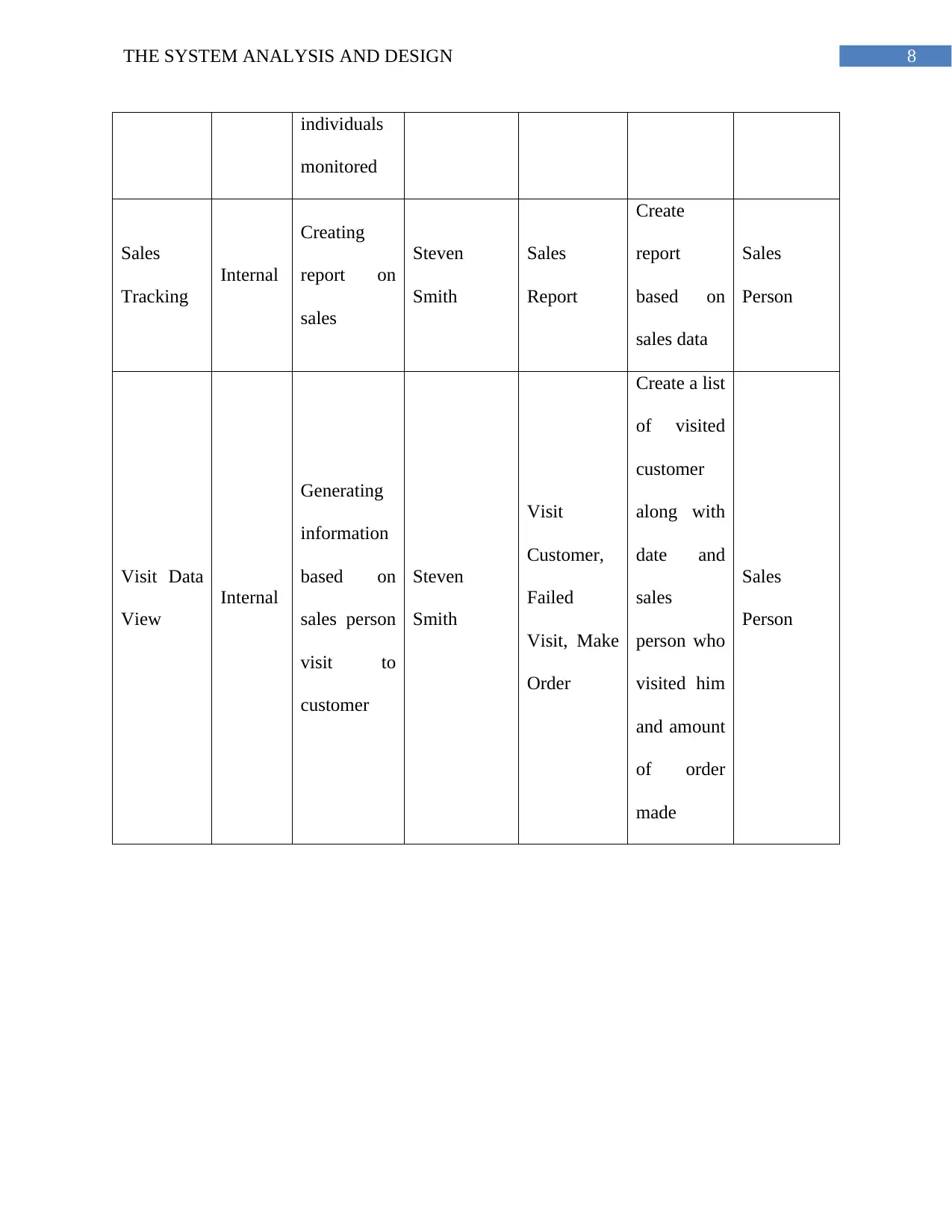
8THE SYSTEM ANALYSIS AND DESIGN
individuals
monitored
Sales
Tracking
Internal
Creating
report on
sales
Steven
Smith
Sales
Report
Create
report
based on
sales data
Sales
Person
Visit Data
View
Internal
Generating
information
based on
sales person
visit to
customer
Steven
Smith
Visit
Customer,
Failed
Visit, Make
Order
Create a list
of visited
customer
along with
date and
sales
person who
visited him
and amount
of order
made
Sales
Person
individuals
monitored
Sales
Tracking
Internal
Creating
report on
sales
Steven
Smith
Sales
Report
Create
report
based on
sales data
Sales
Person
Visit Data
View
Internal
Generating
information
based on
sales person
visit to
customer
Steven
Smith
Visit
Customer,
Failed
Visit, Make
Order
Create a list
of visited
customer
along with
date and
sales
person who
visited him
and amount
of order
made
Sales
Person
⊘ This is a preview!⊘
Do you want full access?
Subscribe today to unlock all pages.

Trusted by 1+ million students worldwide

9THE SYSTEM ANALYSIS AND DESIGN
Use Case:
Use Case Description:
Name Creates Customer
ID UC-Customer-1
Use Case:
Use Case Description:
Name Creates Customer
ID UC-Customer-1
Paraphrase This Document
Need a fresh take? Get an instant paraphrase of this document with our AI Paraphraser

10THE SYSTEM ANALYSIS AND DESIGN
Brief
Description
The retail stores will fill the form and register to be the customer of FFSL
Trigger Customer table will be updated with a new entry
Pre-
Condition
All the filled data must be authentic and valid in the application form
Post
Condition
The retail stores must pass the criteria to be a customer
Activity Retail Store System
Fill the application form Collect data from form
Analyze data
Provide additional details to
management if required
Analyze those data
Accepts the application
Registers as customer
Exception Retail store not in the area but has all the eligible features
Class Diagram:
Brief
Description
The retail stores will fill the form and register to be the customer of FFSL
Trigger Customer table will be updated with a new entry
Pre-
Condition
All the filled data must be authentic and valid in the application form
Post
Condition
The retail stores must pass the criteria to be a customer
Activity Retail Store System
Fill the application form Collect data from form
Analyze data
Provide additional details to
management if required
Analyze those data
Accepts the application
Registers as customer
Exception Retail store not in the area but has all the eligible features
Class Diagram:
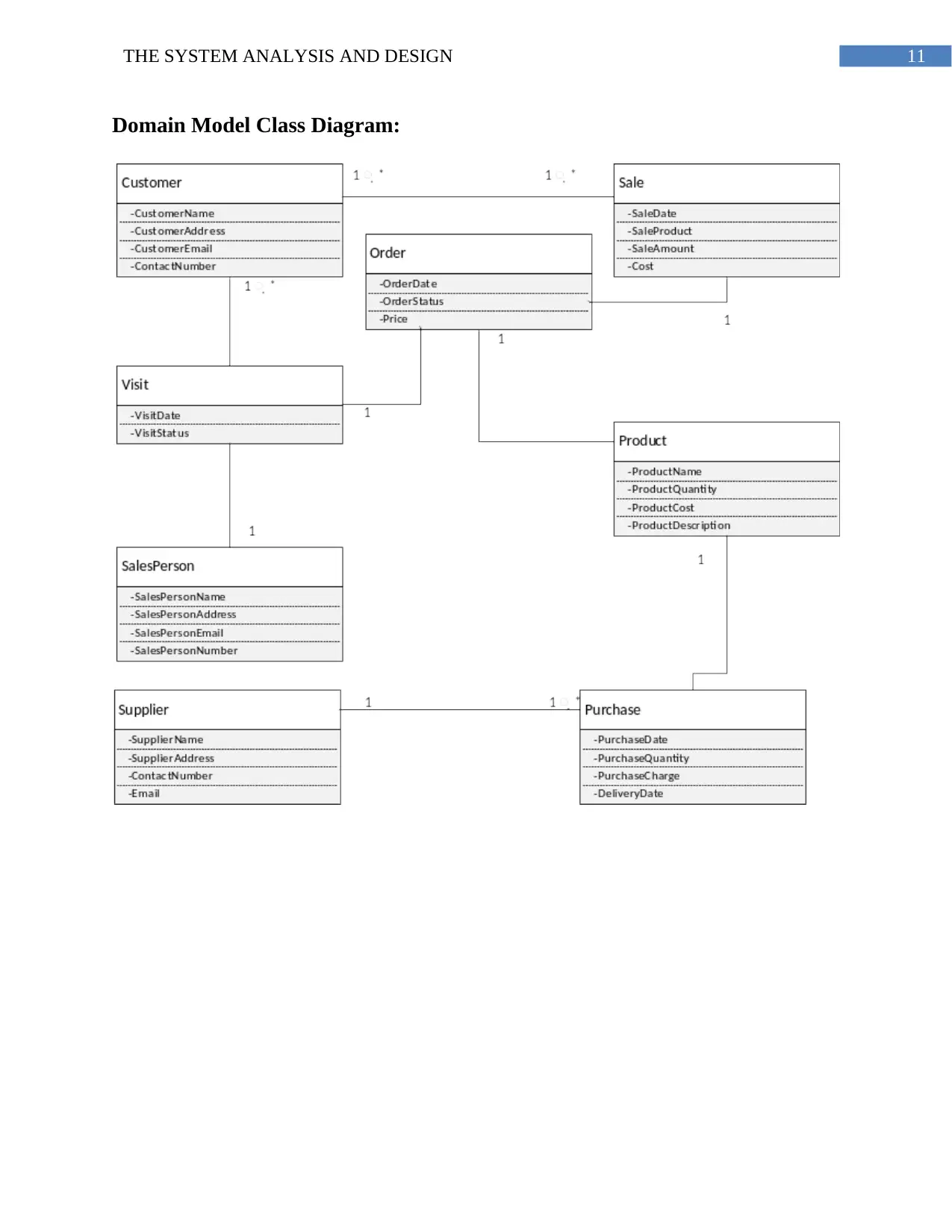
11THE SYSTEM ANALYSIS AND DESIGN
Domain Model Class Diagram:
Domain Model Class Diagram:
⊘ This is a preview!⊘
Do you want full access?
Subscribe today to unlock all pages.

Trusted by 1+ million students worldwide
1 out of 15
Related Documents
Your All-in-One AI-Powered Toolkit for Academic Success.
+13062052269
info@desklib.com
Available 24*7 on WhatsApp / Email
![[object Object]](/_next/static/media/star-bottom.7253800d.svg)
Unlock your academic potential
Copyright © 2020–2025 A2Z Services. All Rights Reserved. Developed and managed by ZUCOL.





